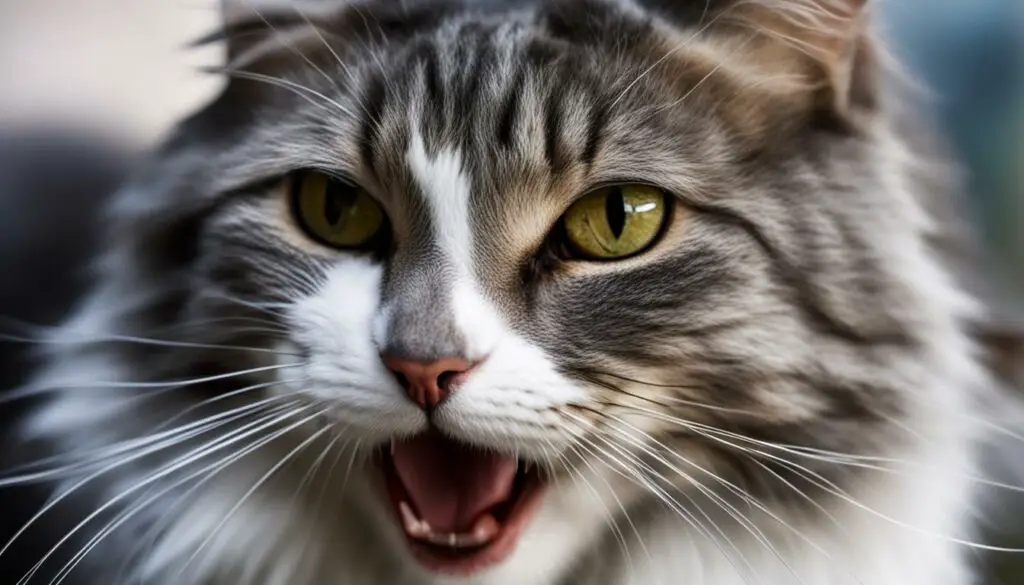Greetings! If you’re a cat owner, you’re probably familiar with the constant meowing that can sometimes drive you up the wall. But fear not, for I am here to shed some light on this noisy behavior and help you understand why your beloved feline just won’t shut up!
Cats are known for their vocal nature, and meowing is their primary means of communication. It’s their way of expressing their needs, emotions, and desires. However, excessive meowing can be frustrating and may indicate an underlying issue that needs to be addressed.
In this article, we’ll explore the various reasons why cats meow excessively and how you can effectively manage their behavior. From understanding their communication signals to addressing their needs, we’ll cover it all. So, let’s dive in and discover why our furry friends can’t seem to keep quiet!
Key Takeaways:
- Cats meow to communicate their needs, emotions, and desires.
- Excessive meowing may indicate an underlying issue that needs to be addressed.
- Understanding your cat’s meow patterns can provide valuable insights into their needs and emotions.
- Proper training, environmental enrichment, and quality time can help reduce excessive meowing.
- Consulting a veterinarian is essential to rule out any health-related concerns.
Understanding Cat Communication and Vocalization
Cats are known for their unique vocalization, and understanding their communication signals is key to deciphering their needs and emotions. Meowing is one of the primary ways in which cats communicate with their owners, expressing a range of emotions, from seeking attention to feeling annoyed or frustrated. By paying attention to the context and intensity of their meows, we can gain valuable insight into their world and provide appropriate responses.
Attention-seeking behavior: Cats often use meowing as a means of seeking attention from their owners. This could be in the form of wanting to play, be fed, or simply seeking companionship. It’s important to differentiate between genuine needs and attention-seeking behavior to effectively address their meows.
Annoyance and frustration: Cats can become annoyed or frustrated when their needs are not met or when they feel their territory is being invaded. Meowing in such instances is their way of expressing their discomfort and seeking a resolution. Identifying the source of their annoyance and providing appropriate solutions can help mitigate excessive meowing caused by these feelings.
Discomfort and irritation: Cats may also meow when they are experiencing discomfort or irritation. This could be due to hunger, thirst, needing to use the litter box, or even experiencing pain. Understanding the possible causes of their discomfort and addressing them promptly can help alleviate their meowing and ensure their well-being.
In conclusion, meowing is a form of communication for cats, and understanding its meaning is essential for effective cat-parent interaction. By recognizing the different contexts and emotions behind their meows, we can better meet our feline companions’ needs and foster a harmonious relationship.
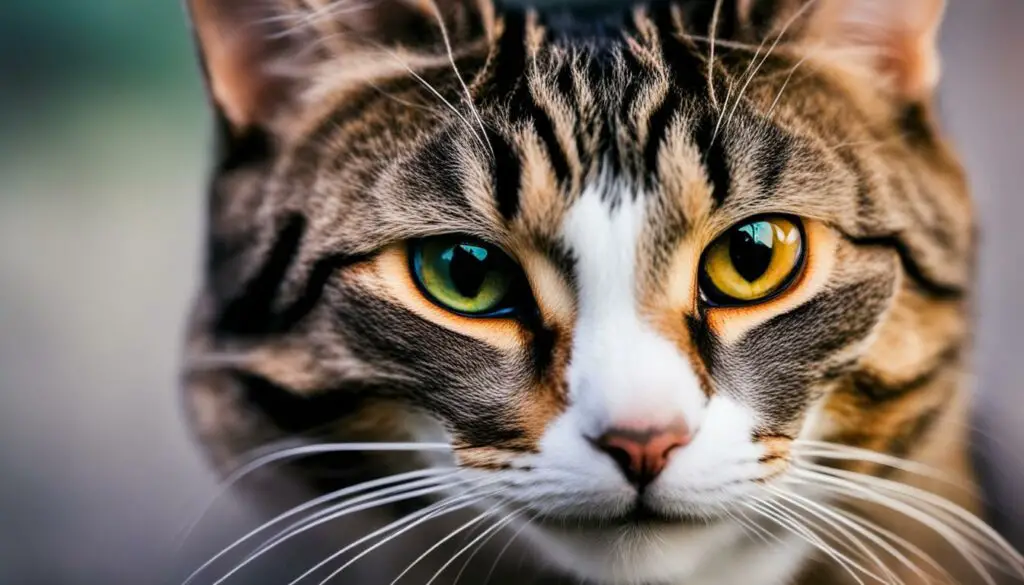
Common Reasons for Excessive Meowing
Excessive meowing in cats can be a frustrating behavior for pet owners to deal with. Understanding the underlying reasons behind this behavior is crucial in effectively addressing it. Here are some common reasons why cats may meow excessively:
- Hunger: One of the most common reasons for excessive meowing is hunger. Cats may meow loudly and persistently when they are hungry, especially if their feeding schedule has been disrupted.
- Thirst: Just like humans, cats need to stay hydrated. If their water bowl is empty or they are not getting enough water, they may become vocal in an attempt to communicate their thirst.
- Discomfort: Cats may meow excessively if they are in physical discomfort. This could be due to various reasons such as a urinary tract infection, dental issues, or even arthritis. If your cat’s meowing is accompanied by other signs of discomfort, it is important to consult a veterinarian for a proper diagnosis and treatment.
- Night Meowing: Some cats have a tendency to meow excessively at night, disrupting their owner’s sleep. This could be due to a variety of reasons such as boredom, anxiety, or a disrupted sleep-wake cycle. Understanding the specific cause of your cat’s night meowing can help in finding appropriate solutions.
It is important to note that excessive meowing can be a symptom of an underlying issue, both medical and behavioral. If your cat’s meowing persists or is accompanied by other concerning symptoms, it is recommended to consult with a veterinarian for a thorough evaluation.
| Reasons for Excessive Meowing | Possible Solutions |
|---|---|
| Hunger | Stick to a consistent feeding schedule and ensure your cat has access to fresh food. |
| Thirst | Keep your cat’s water bowl filled with fresh water at all times. |
| Discomfort | Monitor your cat’s behavior closely and consult with a veterinarian if you suspect any underlying health issues. |
| Night Meowing | Provide a calm and comfortable sleeping environment for your cat and establish a bedtime routine. |
By identifying the specific reasons behind your cat’s excessive meowing and implementing appropriate solutions, you can help create a more peaceful and harmonious environment for both you and your feline companion.
Behavioral Factors Contributing to Excessive Meowing
When it comes to understanding why our cats meow excessively, it is essential to consider various behavioral factors that may contribute to this behavior. Loneliness, boredom, playfulness, territoriality, and mating behavior are all aspects that can lead to excessive meowing in our feline friends.
Cats are social creatures, and loneliness can be a significant trigger for their vocalization. If a cat feels isolated or lacks companionship, they may resort to meowing as a way to seek attention and alleviate their feelings of loneliness. Providing your cat with enough social interaction and companionship can help reduce their meowing caused by loneliness.
Boredom is another common factor behind excessive meowing. Cats need mental and physical stimulation to prevent boredom. Without appropriate activities and environmental enrichment, they may resort to meowing as a way to express their frustration or seek engagement. By offering interactive toys, scratching posts, and engaging in play sessions, you can keep your cat entertained and reduce their meowing caused by boredom.
Territoriality and mating behavior can also contribute to excessive meowing. Cats may meow to assert their territory or express their readiness to mate. Providing a secure environment and addressing their need for territory can help minimize their meowing in these situations. Additionally, spaying or neutering your cat can help reduce their vocalization related to mating behavior.
| Behavioral Factors | Contributing Factors |
|---|---|
| Loneliness | Lack of social interaction and companionship |
| Boredom | Lack of mental and physical stimulation |
| Territoriality | Need to assert territory and mark boundaries |
| Mating behavior | Expression of readiness to mate |
Understanding these behavioral factors and their potential impact on excessive meowing can help pet owners address the underlying causes and effectively manage their cat’s behavior. By providing the necessary social interaction, mental and physical stimulation, and a secure environment, pet owners can foster a harmonious relationship with their cats and minimize the frequency of excessive meowing.
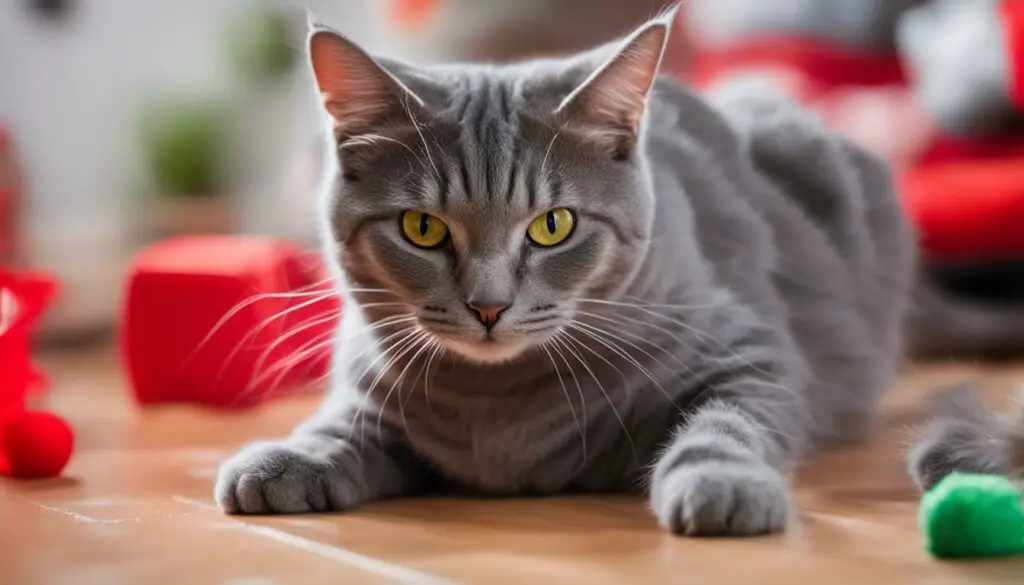
Minimizing Excessive Meowing: Tips and Solutions
- Ensure your cat receives adequate social interaction and companionship.
- Provide environmental enrichment, including interactive toys and scratching posts.
- Engage in regular play sessions to keep your cat mentally and physically stimulated.
- Create a secure environment that addresses your cat’s need for territory.
- Consider spaying or neutering your cat to reduce meowing related to mating behavior.
“Understanding the behavioral factors contributing to excessive meowing is crucial in effectively managing our cats’ behavior and promoting a harmonious environment.”
Section 5: Potential Health Issues and Pain
Excessive meowing in cats can sometimes indicate underlying health issues or pain. It is crucial for pet owners to closely monitor their cat’s behavior and seek veterinary advice if the meowing persists or is accompanied by other concerning symptoms. Regular health check-ups and prompt medical attention are essential in addressing any potential health-related concerns.
Illness can often be a contributing factor to excessive meowing in cats. Conditions such as urinary tract infections, gastrointestinal discomfort, or dental problems can cause discomfort, leading to increased vocalization. It is important to consult with a veterinarian to diagnose and treat any underlying health conditions that may be causing your cat’s excessive meowing.
Pain can also be a reason for cats to meow excessively. Cats may vocalize if they are experiencing discomfort or suffering from injuries. Identifying the source of pain and providing appropriate pain management can help alleviate excessive meowing. Your veterinarian can evaluate your cat’s condition and recommend the necessary treatment options to ensure their well-being.
| Potential Health Issues | Pain Assessment and Management |
|---|---|
| Urinary tract infections | Diagnosis and treatment by a veterinarian |
| Gastrointestinal discomfort | Identifying and addressing the underlying cause |
| Dental problems | Dental examination and treatment procedures |
| Injuries or physical discomfort | Pain management and veterinary care |
Remember, if your cat’s excessive meowing persists or if you have any concerns about their health, it is always best to consult with a qualified veterinarian. They can provide the necessary guidance and support to ensure your cat’s well-being and help address any potential health issues that may be contributing to their excessive vocalization.
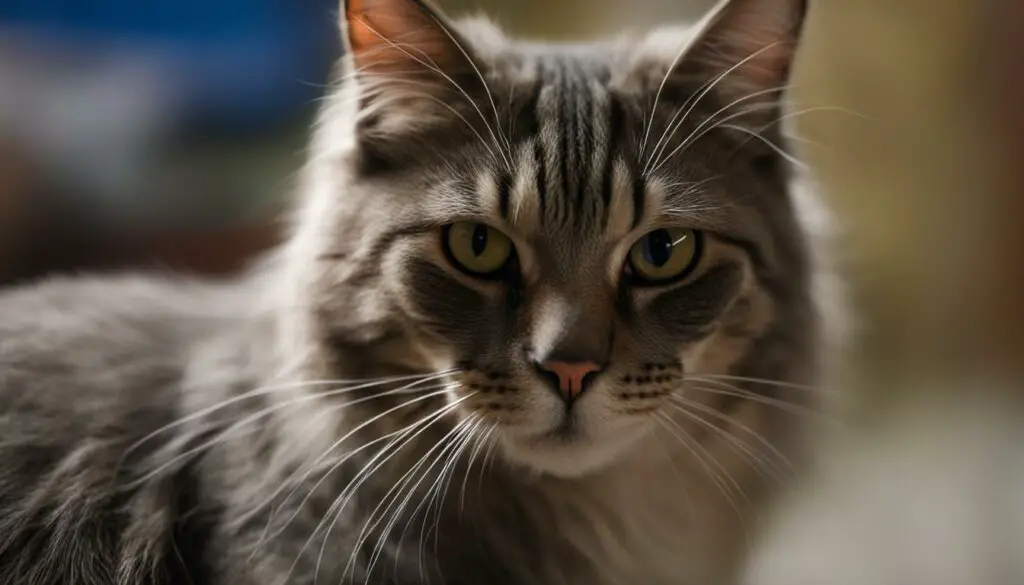
Analyzing Meow Patterns and Cat-Human Interaction
Understanding and analyzing meow patterns can provide valuable insights into a cat’s needs and emotions. Cats use vocalization as a means of communication, and by paying attention to their meows, pet owners can deepen their understanding of their furry companions. Meowing can vary in pitch, duration, and intensity, each carrying a unique message that requires interpretation.
Cat-human interaction plays a significant role in shaping a cat’s behavior and reducing excessive meowing. When a cat meows, it is essential for pet owners to respond appropriately to foster a harmonious relationship. By acknowledging and addressing a cat’s meow, pet owners can establish trust and strengthen the bond between human and feline.
“Meow analysis involves observing the context, tone, and accompanying body language to decipher a cat’s meow,” says Dr. Emily Collins, a renowned veterinarian.
Cats may meow to indicate hunger, thirst, a desire for attention, or to seek comfort. It is crucial for pet owners to respond accordingly and provide the necessary care and attention.
Understanding Human Response to Cat Meows
How humans respond to cat meows also influences a cat’s behavior. Cats are astute observers and may modify their meowing patterns based on how their human companions react. Responding consistently and positively to a cat’s meow can reinforce desired behaviors, while inadvertently reinforcing unwanted behaviors by reacting inconsistently.
| Human Response | Effect on Cat Behavior |
|---|---|
| Ignoring the meow | May discourage attention-seeking behavior |
| Responding with positive attention | May reinforce meowing as a way of seeking attention |
| Responding with punishment | May increase fear and anxiety, leading to more meowing |
Developing a consistent and appropriate human response to meows is crucial. Providing attention and positive reinforcement when a cat meows for a legitimate reason, such as hunger or thirst, can encourage healthy communication. However, reinforcing meowing solely for attention-seeking purposes may lead to excessive vocalization.

Understanding meow patterns and proper cat-human interaction can lead to a more fulfilling and harmonious relationship. By analyzing and responding appropriately to their meows, pet owners can better meet their cat’s needs and reduce excessive meowing. Remember, every meow carries a unique message waiting to be understood.
Calming Techniques and Distraction Methods
Dealing with excessive meowing can be challenging, but employing calming techniques and distraction methods can help alleviate this behavior. Cats often meow to seek attention or express their frustration, and it’s important to provide them with alternative outlets for their energy and emotions.
Calming Techniques
One effective calming technique is creating a soothing environment for your cat. This can include providing a quiet space for them to retreat to, using calming pheromone sprays, or playing soft music to create a relaxing atmosphere. Additionally, gentle petting and massage can help reduce anxiety in cats.
Another technique is the use of interactive toys that engage your cat’s natural instincts. Puzzle toys or treat-dispensing toys can provide mental stimulation and distract your cat from excessive meowing. These toys help redirect their focus and provide a constructive outlet for their energy.
Distraction Methods
Distraction methods can be particularly effective in diverting your cat’s attention away from meowing. Interactive play sessions, such as using a feather wand or laser pointer, can keep your cat engaged and mentally stimulated. Regular playtime not only provides physical exercise but also helps strengthen the bond between you and your cat.
Additionally, providing scratching posts and climbing trees can give your cat an appropriate outlet for their natural behaviors. Cats often meow when they feel the need to stretch or scratch, so having designated areas for these activities can help prevent excessive vocalization.
| Calming Techniques | Distraction Methods |
|---|---|
| Create a soothing environment | Use interactive toys |
| Gentle petting and massage | Engage in interactive play |
| Calming pheromone sprays | Provide scratching posts |
| Play soft music | Offer climbing trees |
By implementing these calming techniques and distraction methods, you can help reduce excessive meowing in your cat and create a more peaceful and harmonious environment for both of you.

Training and Discipline
When it comes to addressing excessive meowing in cats, training and discipline play a crucial role. Using positive reinforcement techniques can be highly effective in shaping a cat’s behavior and reducing unwanted vocalization. By rewarding desired behaviors and discouraging excessive meowing, pet owners can establish clear boundaries and promote more harmonious interactions.
One important aspect of training is establishing consistent cues and signals. Cats are intelligent animals and can quickly learn to associate certain actions or words with specific behaviors. By using consistent and clear cues, such as a hand gesture or a verbal command, pet owners can communicate their expectations to their cats effectively.
Discipline, on the other hand, should focus on redirecting a cat’s behavior rather than punishment. Ignoring unwanted meowing and redirecting their attention to more appropriate activities can be effective in discouraging excessive vocalization. It’s important to remain patient and consistent throughout the training process, as cats may take time to adjust to new behaviors.
Key Points:
- Positive reinforcement techniques are effective in training cats to reduce excessive meowing.
- Establishing consistent cues and signals helps cats associate specific behaviors with commands.
- Discipline should focus on redirecting behavior rather than punishment.
- Patience and consistency are key when training cats to modify their vocalization behavior.
| Training and Discipline Methods | Benefits |
|---|---|
| Positive reinforcement |
|
| Consistent cues and signals |
|
| Redirecting behavior |
|
By implementing these Training and Discipline Methods, pet owners can help their cats reduce excessive meowing and create a more peaceful and harmonious environment. Remember to always use positive reinforcement, be consistent, and prioritize the well-being and needs of your furry companion.
Environmental Enrichment and Interactive Toys
Creating an environment that stimulates your cat’s natural instincts is essential in reducing excessive meowing. Environmental enrichment can help keep your feline friend mentally and physically engaged, preventing boredom and frustration. Interactive toys, scratching posts, and the use of catnip are effective ways to provide enrichment and alleviate excessive meowing.
Interactive Toys
Interactive toys are a fantastic way to engage your cat’s hunting instincts and keep them mentally stimulated. Toys that mimic prey, such as feather wands or laser pointers, can provide hours of entertainment and help redirect their focus away from excessive meowing. Additionally, puzzle toys that dispense treats can challenge your cat’s problem-solving skills, providing mental stimulation while rewarding them for their efforts.
Scratching Posts
Scratching is a natural behavior for cats, and providing appropriate scratching posts can prevent destructive scratching while also offering environmental enrichment. The scratching post should be tall enough for your cat to fully stretch and sturdy enough to withstand their scratching. Place the scratching post in a prominent location, like near their favorite resting spots or in areas where they tend to scratch furniture, to encourage its use.
| Benefits of Scratching Posts | Types of Scratching Posts |
|---|---|
|
|
The Power of Catnip
Catnip is a naturally occurring herb that can have a significant impact on your cat’s behavior. Many cats are drawn to catnip and can experience a range of reactions, including increased playfulness, relaxation, and reduced anxiety. Introducing catnip into your cat’s environment can provide sensory enrichment and help minimize excessive meowing. Sprinkle catnip on their toys, bedding, or scratching posts to encourage exploration and play.
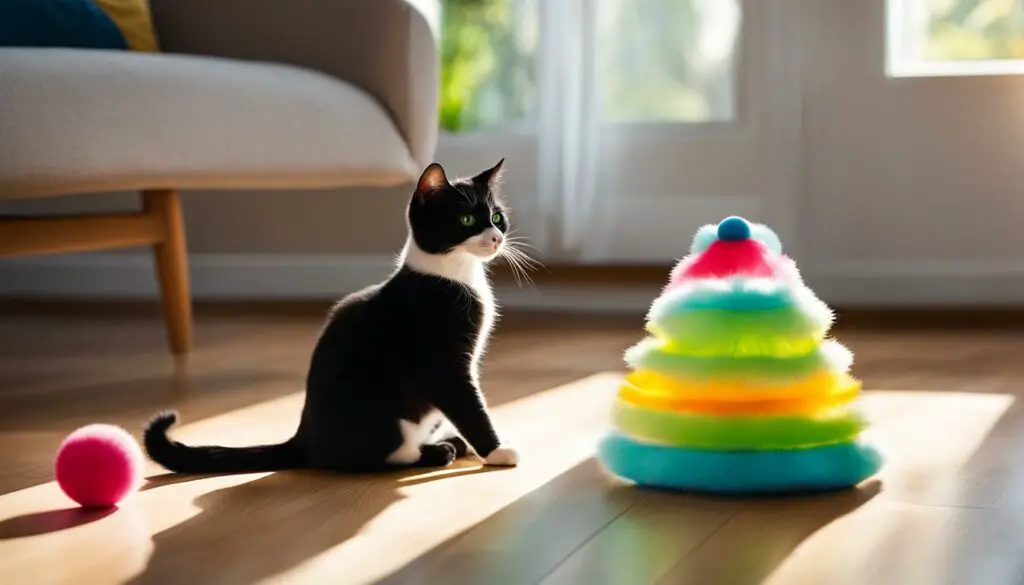
Remember, every cat is unique, so try different types of interactive toys and observe what captures their interest the most. Provide a variety of scratching posts and regularly refresh the catnip to maintain its effectiveness. With the right environmental enrichment and interactive toys, you can create a stimulating and engaging environment that will keep your cat entertained and reduce excessive meowing.
Quality Time and Mental Stimulation
When it comes to addressing excessive meowing in cats, spending quality time with them is key. Cats crave companionship and interaction, and dedicating time to play and engage with them can fulfill their needs and reduce attention-seeking behavior. Interactive play sessions not only provide mental stimulation but also strengthen the bond between you and your feline friend.
During interactive play, use toys that encourage your cat to chase, pounce, and swat. This mimics the hunting instincts of cats and keeps them mentally engaged. You can try using feather wands, laser pointers, or puzzle toys that dispense treats. These activities provide both physical exercise and mental stimulation, which can help reduce excessive meowing.
Additionally, incorporating mental stimulation in your cat’s daily routine can prevent boredom and the associated meowing. Puzzle toys and treat-dispensing toys require cats to think and problem-solve, keeping their minds active and occupied. Clicker training is another great way to provide mental stimulation while teaching your cat new tricks or behaviors.
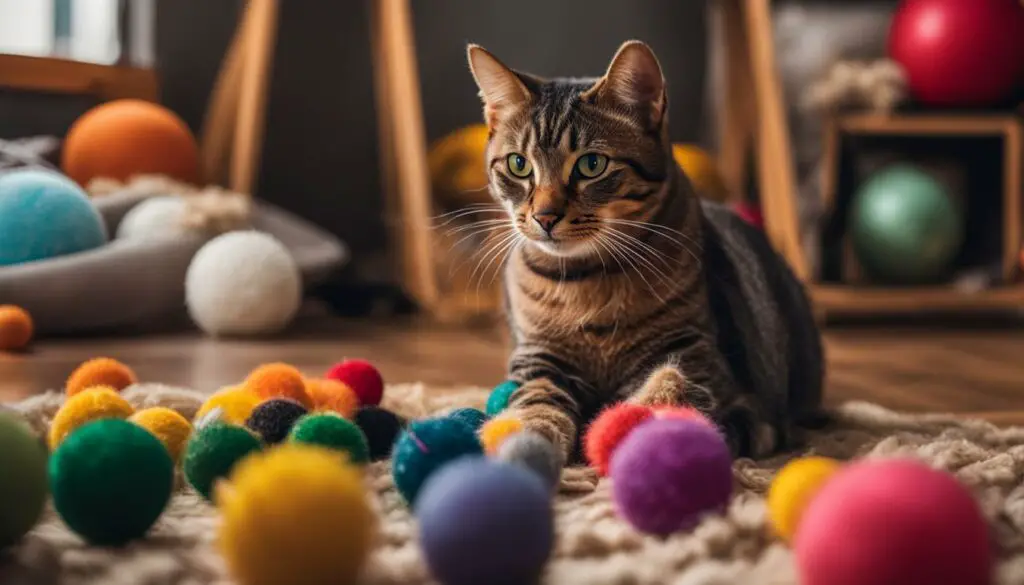
Remember, every cat is unique, so it’s important to pay attention to your cat’s preferences and adjust your playtime and mental stimulation activities accordingly. By providing quality time and mental stimulation, you can help reduce excessive meowing and create a happier and more contented cat.
Ensuring Good Health with Veterinary Advice
When it comes to addressing excessive meowing in cats, seeking veterinary advice is essential for ensuring their overall health and well-being.
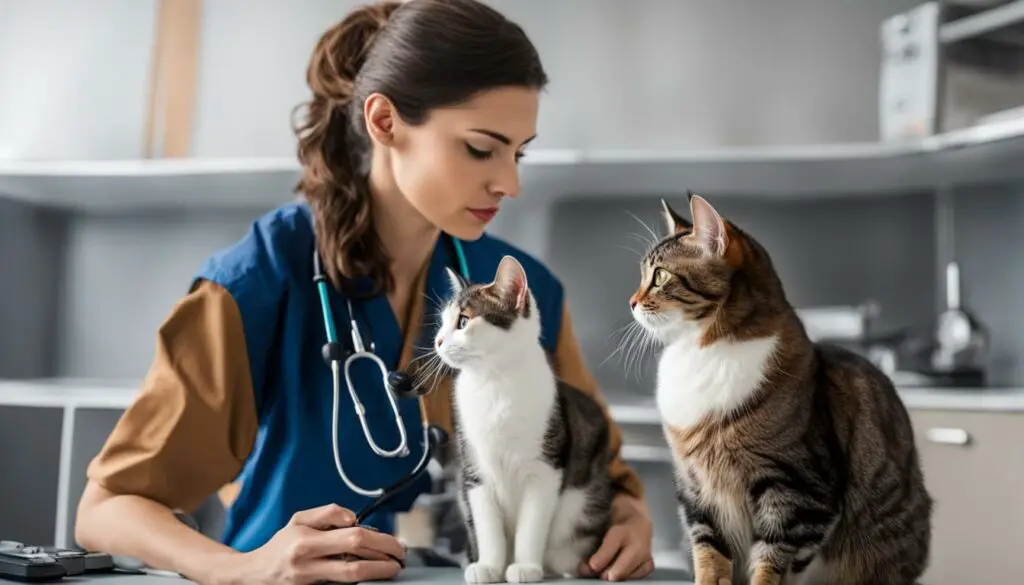
A health check-up with a veterinarian can help identify any underlying health conditions that may be contributing to the excessive meowing. It is important to monitor the cat’s behavior closely and look out for any other concerning symptoms that may accompany the meowing. Veterinary professionals have the expertise to conduct thorough examinations and provide guidance on managing the behavior effectively.
In addition to addressing potential health issues, a veterinarian can offer valuable advice on managing behavioral aspects related to excessive meowing. They can provide insights on creating a nurturing environment, implementing training techniques, and using positive reinforcement to shape the cat’s behavior. Consulting with a veterinarian ensures a comprehensive approach to managing excessive meowing and promotes the overall well-being of the cat.
Why Veterinary Advice Matters
- Expertise: Veterinarians are highly trained professionals with the knowledge and experience to diagnose underlying health conditions and behavioral issues.
- Individualized Care: Each cat is unique, and veterinary advice provides personalized recommendations tailored to the specific needs of the cat.
- Prevention and Early Detection: Regular health check-ups can help prevent health problems and detect any issues early on, before they escalate.
- Comprehensive Approach: Veterinary advice takes into account both the physical and behavioral aspects of a cat’s well-being, ensuring a holistic and effective approach to managing excessive meowing.
By seeking veterinary advice and following their recommendations, pet owners can ensure the good health of their cats and address any behavioral issues that may contribute to excessive meowing.
Addressing Separation Anxiety
Separation anxiety is a common issue that many cats experience when they are separated from their owners. It can manifest in excessive meowing, destructive behavior, or other signs of distress. To help your cat cope with separation anxiety, it is important to implement gradual changes and provide a secure and comforting environment.
One effective technique for addressing separation anxiety is desensitization. This involves gradually increasing the amount of time your cat spends alone, starting with short periods and gradually extending them. By doing so, you can help your cat become more accustomed to being alone and reduce their anxiety.
Creating a safe and comfortable space for your cat when you’re not home is also crucial. This can include providing cozy bedding, leaving out familiar objects with your scent, or using calming pheromone diffusers. These measures can help your cat feel more secure and alleviate their anxiety.
“Separation anxiety can be distressing for both cats and their owners. By implementing gradual changes and making your cat’s alone time as comfortable as possible, you can help reduce their anxiety and minimize excessive meowing.”
Additionally, it is important to ensure your cat has engaging activities to keep them mentally stimulated. Interactive toys, scratching posts, and puzzle feeders can help keep their minds occupied and distract them from their anxiety. Incorporating regular play sessions and providing quality time when you are home can also help strengthen their bond with you and reduce anxiety-related behaviors.
| Techniques for Addressing Separation Anxiety in Cats |
|---|
| Desensitization |
| Creating a secure environment |
| Providing engaging activities |
| Allotting quality time for bonding |
Dealing with separation anxiety in cats requires patience and understanding. By implementing these strategies and seeking guidance from a veterinarian if needed, you can help your cat feel more at ease when you’re not around, reducing excessive meowing and promoting their overall well-being.
Conclusion
In conclusion, understanding why cats meow excessively is crucial in addressing their needs and managing their behavior. By decoding their vocal signals and recognizing their emotions, we can effectively respond to their communication and reduce annoyance caused by excessive meowing.
There are various reasons why cats meow excessively, including hunger, discomfort, loneliness, and boredom. Identifying the underlying cause is vital in finding appropriate solutions. Regular health check-ups with a veterinarian can help rule out any underlying health issues that may be contributing to the behavior.
Implementing strategies such as training, environmental enrichment, and spending quality time with our cats can create a harmonious environment and minimize excessive meowing. Positive reinforcement, providing interactive toys, and ensuring mental stimulation are effective methods in managing this behavior.
In conclusion, by understanding and addressing our cats’ needs, establishing clear boundaries, and seeking professional veterinary advice when necessary, we can create a fulfilling and rewarding cat-human relationship, where excessive meowing is minimized, and both parties can enjoy a peaceful and happy coexistence.
FAQ
Why does my cat meow excessively?
Cats meow excessively for various reasons, including hunger, thirst, discomfort, loneliness, boredom, territoriality, mating behavior, or underlying health issues.
How can I address excessive meowing in my cat?
Understanding the cause of excessive meowing and addressing their needs through training, environmental enrichment, mental and physical stimulation, and quality time can help reduce excessive meowing in cats.
When should I consult a veterinarian about my cat’s excessive meowing?
If your cat’s excessive meowing persists or is accompanied by other concerning symptoms, it is important to consult a veterinarian for a thorough examination and professional advice.
How can I provide mental and physical stimulation for my cat?
You can provide mental and physical stimulation for your cat through interactive toys, scratching posts, stimulating activities, puzzle toys, clicker training, and play sessions.
Is excessive meowing a sign of separation anxiety?
Excessive meowing can be a sign of separation anxiety in cats. Gradual desensitization techniques, providing comforting resources, and ensuring a secure environment can help address separation anxiety.
How can training and discipline help address excessive meowing?
Positive reinforcement techniques can be used to reward desired behaviors and discourage excessive vocalization. Establishing clear boundaries and using appropriate discipline methods, such as redirecting behavior or ignoring unwanted meowing, can help shape a cat’s behavior effectively.
What can I do to create a soothing environment for my cat?
Creating a soothing environment for your cat can include providing a comfortable and safe space, minimizing loud noises or disruptions, and using calming techniques such as pheromone diffusers or music designed for cats.
How often should I take my cat to the veterinarian for check-ups?
Regular health check-ups with a veterinarian are essential in maintaining your cat’s overall wellbeing. Consult with your veterinarian on the recommended frequency of check-ups based on your cat’s age and health status.
Can excessive meowing be a sign of pain or illness in cats?
Excessive meowing in cats can sometimes be an indication of underlying health issues or pain. Monitor your cat’s behavior closely and consult a veterinarian if the meowing persists or is accompanied by other concerning symptoms.
How can I establish a stronger bond with my cat and minimize excessive meowing?
Understanding your cat’s communication signals, spending quality time together, engaging in interactive play sessions, and tailoring your responses to their needs can establish a stronger bond and minimize excessive meowing.

